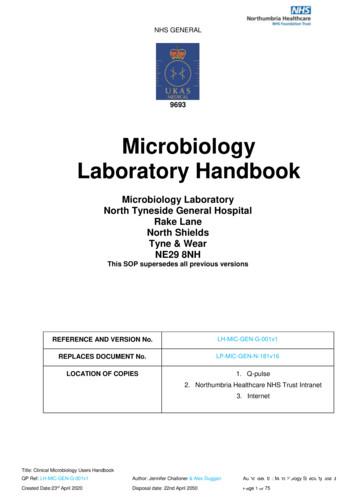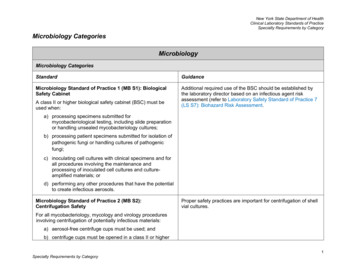General Microbiology Laboratory
General MicrobiologyLaboratoryManualMedical Technology DepartmentIslamic University-GazaDr. Abdelraouf A. Elmanama (Ph.D. Microbiology)2009
General Microbiology Manual قال رسول ﷲ صلى ﷲ عليه وسلم َ ﺍجملﺬﻭﻡ ﻛﻤﺎ ﺗﻔﺮ ﻣﻦ ﺍﻷﺳﺪ( ) ﻻ ﻋﺪﻭﻯ ﻭﻻ ﻃﲑﺓ ﻭﻻ ﻫﺎﻣﺔ ﻭﻻ ﺻﻔﺮ ، ﻭﻓﺮ ﻣﻦ صدق رسول ﷲ صلى ﷲ عليه وسلم 2 Abdelraouf A. Elmanama Ph. D Microbiology
General Microbiology Manual وصف المساق اسم المادة : أحياء دقيقة طبية أساسية عملية رقم المادة MEDI 3101: الفصل : األول 2009 عدد الساعات اإلجمالية : ساعة واحدة معتمدة ) ٣ ساعات عملية( وصف المساق : يتناول المساق المواضيع المتعلقة بكيفية استخدام الميكروسكوب والتعامل مع أكثر الصباغات استخداما ً في مختبرات الميكروبيولجي ، وكيفية استخدام الفحوصات البيوكيميائية مع التطرق لبعض أنواع البكتيريا المرضية وكيفية تعريفھا وعدھا ومن ثم شرح مفصل للمضادات الحيوية و تصنيفھا وتأثيراتھا . متطلبات سابقة : أحياء عامة عملية مدرس المساق : ً االسم : J121 المكتب : 2673 الھاتف : مدرس مساعد : Microbiology Laboratory Manual prepared by Abdelraouf Elmanama المرجع المعتمد : (Diagnostic Microbiology) author: BAILEY &SCOT’S مراجع أخرى : .١ استخدام الميكروسكوب بالشكل الجيد الذي يتيح من خالله تعريف الشرائح البكتيرية . أھداف المساق : .٢ كيفية الحصول على مزارع بكتيرية نقية وخالية من التلوث . .٣ صباغة البكتيريا بأنواع الصباغات المختلفة واستخدامھا في تعريف البكتيريا . .٤ تطبيق الفحوصات البيوكيميائية المختلفة بھدف تعريف البكتيريا . .٥ طرق تشخيص البكتيريا سالبة الجرام من عائلة Enterobacteriaceae و Pseudomonas .٦ طرق تشخيص البكتيريا موجبة الجرام من عائلة Staphylococcus و Streptococcus .٧ استخدام الفحوصات الكيميائية والمصلية في تشخيص أنواع البكتيريا سابقة الذكر .٨ تحديد المضادات الحيوية ذات الحساسية ألنواع البكتيريا المختلفة وتصنيفھا وكيفية آلية تأثيرھا . .٩ كيفية معرفة العدد التقديري للبكتيريا في العينة األساسية بواسطة الطرق المختلفة .١٠ تحضير األوساط الغذائية للبكتيريا الحصول على قدر من المعلومات يضع الطالب على بداية الطريق من خالل تعامله الجيد مع الميكروسكوب الناتج المتوقع أن يحصل عليه الطالب : في تشخيص البكتيريا التي تمت صباغتھا ومن ثم استخدام الفحوصات البيوكيميائية في تعريف البكتيريا ، ومن ثم عزل البكتيريا الممرضة وتشخيصھا بالطرق المتبعة في ھذا المجال واختيار المضادات الحيوية ذات الحساسية المناسبة لھا استخدام الحاسوب : يتم تدريب الطالب على استخدام الحاسوب في تشخيص البكتيريا الممرضة المعزولة حسب الفحوصات الكيميائية التي ظھرت معه في المعمل بإدخال البيانات المطلوبة على نوعين من البرامج الخاصة المستخدمة دوليا ً لتعريف البكتيريا درجة 30 امتحان نظري نصفي . توزيع الدرجات : درجة 10 بحث على شكل بوربوينت مع الشرح . درجة 10 حضور و تقارير معملية ونشاط . درجة 50 امتحان نظري نھائي . يتم االتفاق على موعد االمتحان النصفي والتھائي الحقا . تاريخ االمتحانات : 3 Abdelraouf A. Elmanama Ph. D Microbiology
General Microbiology Manual خطة طرح المساق Course n1.5Introduction to the oil immersion compound microscopeSimple stain, Gram stainAcid fast stainThe spore stain, and negative stainIsolation of pure culture and sterile transferBacterial motility.Amylase Production add Gelatin LiquefactionCatalase ProductionCoagulase TestOxidase ProductionMethyl Red & Voges-Peoskauer Tests (MR-VP)Tryptophan Hydrolysis (Indole Test)Citrate Utilization Test, Urease TestNitrate Reduction TestMedia preparation & SterilizationSingle Media / Multiple Tests, Triple Sugar Iron AgarSelective and differential mediaBacterial oxygen requirementsAnaerobic bacteriaThe serial dilution method of bacterial enumeration and generation timeMicrobial control agentsGram positive coccus identificationPseudomonas identificationEnterobacteriaceae identificationIdentification of unknown bacteriaMicrobes in the atmosphereMicrobes in the .51.51.51.531.51.51.51.51.51.51.5Abdelraouf A. ElmanamaPh. D Microbiology4
General Microbiology ManualTable of ContentsExerciseIntroductionMicrobiology Laboratory safety rulesGlossary of termsExercise 1: Introduction to the oil immersion compound microscopeExercise 2: Staining techniqueExercise 2.1: Simple StainsExercise 2.2: A. The Gram stainExercise 2.2: B. The acid-fast stainExercise 2.3: A. The spore stainExercise 2.3: B. Negative Stain (CAPSULE)Exercise 3: Aseptic techniqueExercise 3: A. sterile techniqueExercise 3: B. sterile transfersExercise 3: C. Isolation of pure culturesExercise 4: Bacterial MotilityExercise 5: Catalase TestExercise 6: Coagulase TestExercise 7 : Amylase productionExercise 8 : Gelatin LiquefactionExercise 9 : bacterial metabolism and carbohydrate fermentationExercise 10: Oxidase ProductionExercise 11: Methyl Red and Voges-Peoskauer TestsExercise 12: Tryptophan hydrolysis ( Indole Production )Exercise 13: Citrate UtilizationExercise 14: Urease TestExercise 15: Nitrate production TestExercise 16: Media Preparation & SterilizationExercise 17: Single Media \ Multiple mediaExercise 12: Selective and differential mediaExercise 19: Bacterial oxygen requirementsExercise 20: Anaerobic bacteriaExercise 21: The serial dilution method of bacterial enumerationExercise 22: Bacterial generation timeExercice 23: Microbial control agentsExercice 24: A. Gram positive coccus identificationExercice 24: B.Pseudomonas identificationExercice 24: C. Enterobacteriaceae identificationExercise 24: D. Identification of unknown bacteriaExercise 24: E. Microbes in the atmosphereExercise 24: F. Microbes in the soilSelected websiteAppendicesAbdelraouf A. ElmanamaPh. D 241261275
معمل الميكروبيولوجي) (J121 General Microbiology Manual احذر احذر!!!!!!!! أنت تعمل في بيئة خطرة بيولوجيا لذا عند الدخول للمعمل والبدء بممارسة الفحوصات العملية ومغادرة المعمل عليك إتباع إرشادات السالمة . قبل البدء بإجراء الفحص المقرر يجب التزام بالتالي : يمنع منعا باتا األكل والشرب أو جلب طعام آو شراب إلى المعمل . يجب غسل اليدين بالماء والصابون قبل البدء باجرا الفحص . يجب ارتداء القفازات لضمان الوقاية من أي عينات ممرضة أثناء التعامل معھا . يجب ارتداء المعطف األبيض النظيف . على األخوات الطالبات وضع غط اء ال رأس داخ ل المعط ف م ع تغطي ة أكم ام المعط ف ألكم ام المالب س لتجن ب التل وث ب أي عينات ممرضة . أثناء إجراء الفحص المقرر يجب التزام بالتالي : تحضير األدوات وكافة المواد الالزمة في منطقة العمل لالستفادة من الوقت . يجب عدم التجول في المعمل إال للضرورة وبحذر وانتباه واحرص على عدم التحدث . احرص على التخلص من األدوات الحادة المستخدمة في الحاوية المخصصة لذلك . في حال تعرضك ألي حادث عرضي أو انسكاب أي من المحاليل الكيميائية أو العينات الممرضة يجب إبالغ المدرس المشرف على المعمل للقيام باإلجراءات الالزمة للحفاظ على سالمتك . عند االنتھاء من إجراء الفحص المقرر يجب التزام بالتالي : تأكد من إعادة جميع األدوات المستخدمة إلى مكانھا المخصصة . تأكد من إغالق كافة األجھزة التي تم استخدمھا . احرص على نظافة منطقة العمل المخصص بك . قم بخلع المعطف أوال ثم القفازات . يجب وضع المعطف المستخدم في الحقيبة الخاص به لتجنب مالمسة القرطاسية . إعادة المقعد للمكان المخصص به . مالحظة / يمنع التجمع في المعمل قبل الوقت المحدد أو الخروج منه دون أذن المشرف على المعمل . شكرا لكم على حسن اھتمامكم قسم التحاليل الطبية –الجامعة اإلسالمية - غزة أنا الطالب / ة . قد قرأت ما ورد من إرشادات وعليه أتعھد بااللتزام التوقيع .: 6 Abdelraouf A. Elmanama Ph. D Microbiology
General Microbiology ManualIntroductionWelcome to the microbiology laboratory. The goal of the laboratory is to expose students to thewide variety of lives in the microbial world. Although the study of microbiology includesbacteria, viruses, algae and protozoa, this lab will concentrate primarily on the bacteria.Microbiological techniques are important in preparing the students for the much harder task ofidentifying the pathogenic microorganisms in a clinical and environmental specimen. In thismanual, I started each experiment with a brief theoretical introduction revealing the theoreticalbasis on which the experiment is based on, so that there will be a strong conjunction between thepractical and theoretical sessions. Included in this manual also, the safety precautions which areessential for every one in the field of microbiology.Bacteria belong to the kingdom Monera. This kingdom contains more biological diversity thanall other kingdoms combined. Most people tend to associate bacteria with disease, but less thanten percent of all bacteria cause disease. Many bacteria cannot even live at the temperaturesfound in and on the human body. In this lab, most of the bacteria with which we will be workingare non-pathogenic (do not cause disease). However, some of the bacteria are opportunistic;that is, they can cause disease in an ill or injured person. Therefore, treat all bacteria as if theyare pathogenic (cause disease).Laboratory Safety RulesThese rules are for the safety of the students, instructors and support staff. Please read andfollow them. Failure to follow safety rules may result in removal from the class.1. Wear a lab coat in lab. We will be working with a variety of materials that can causepermanent stains on some fabrics. Also, a lab coat can help protect from accidentalcontamination by microorganisms.2. No eating or drinking during lab. Many pathogens spread by ingested food and drink. Inaddition, food can carry microorganisms that might contaminate laboratory cultures.3. Keep long or fluffy hair tied up and out of the way. Hair can contaminate and becontaminated by microbial cultures.4. Always wear shoes in lab.5. Thoroughly wash your hands with soap and water before and after lab. Thorough andfrequent hand washing easily and effectively controls the spread of many pathogens.6. Clean the lab bench with disinfectant before and after lab. This helps to preventcontamination of cultures, books, clothing, etc.Abdelraouf A. ElmanamaPh. D Microbiology7
General Microbiology Manual7. Keep the lab bench free of unnecessary materials. Don't use the lab bench as a storagearea for coats, books, etc.8. Do not take cultures from the lab area.9. Dispose of all contaminated materials in autoclave bags. When in doubt, ask theinstructor.10. Immediately report all accidents and spills to the instructor. Cover spills withdisinfectant-soaked paper towels for at least 15 minutes before disposing of them.11. Read all assigned materials before the lab session. Experiments will go smoother andhave greater chances of success when you know what you will be doing ahead of time.12. Treat all microbial cultures as if they are pathogens. Better safe than sorry.13. When in doubt, ask the instructor. The only stupid questions are those that are intendedas such.NOTES:1. Personal belongings are not to be stored in the laboratory.2. You will be assigned to a group consisting of four students and you will work together ina semester long project.3. Please read the safety instructions posted in the lab.Abdelraouf A. ElmanamaPh. D Microbiology8
General Microbiology ManualGlossary of termsAerobic: Requires oxygen (opposite of anaerobic).Agar: Powder added to media for solidification.Air-dry: Drying of slide suspension in air before heat fixing and staining.Analog: Similar structure, but not identical.Antibody: Specific, protective protein produced by the immune system in response to anantigen.Antigen: Foreign, non self immunogenic material that elicits an immune response.Atrichous: Without flagella, nonmotile.Autoclave: Moist heat method of sterilization using pressure.Axial filament: A structure for motility used by the Spirochment bacteria.BHI: Brain heart infusion, a really good enrichment medium.Broth: media without agar.Brownian movement: Vibrations of an object seen in a microscope, not true motility.Candle jar: Candle burns in a closed container producing a carbon dioxide incubator, containing2-10%O2 and around 10% CO2.CFU: Colony- forming unitesCAN: Columbia naladixic acid media, selective (for Gram positive) and differential medium.Coliforms: Gram- rods which ferment lactose, non spore forming.Colony: A visible mass of bacteria growing on solidified medium, a clone.Differential stain: Uses 2 or more dyes which allow differentiation between different bacteriagroups or structures.Counter stain: The 2nd dye added to a smear, taken in after the wall is decolorized, e.g. safrinin,methylene blue.Declorizer: The reagent used to remove the primary dye from the cell wall in a differential staine.g. acid alcohol, acetone- alcohol.Abdelraouf A. ElmanamaPh. D Microbiology9
General Microbiology ManualPrimary dye: The 1st dye used in a differential stain, e.g. malachite green, crystal violet.EMB: Eosin methylene blue medium, selective (for Gram negative) and differential medium.Exoenzyme: Enzyme excreted away from the cell.Facultative anaerobe: Uses oxygen when present but can either ferment or an aerobicallyrespire without it.Fastidious: Hard-to- grow bacteria, requiring grow factors or particular nutrients.Microaerophilic: Likes a reduced oxygen concentration.Obligate aerobe: Requires oxygen to grow.Fecal coliforms: Gram- rod which ferment lactose, non spore forming, GI flora in animals, infeces.Genus: Category of organisms with like features and closely related, divided into species.Heat- fix: Use of flame to1. Coagulate proteins of suspension, causing adherence to slide.2. Kill the microbes.IMVIC: Acronym indole, methyl red, Voges- proskauer, citrate.MIC: Minimal inhibitory concentration of antibiotic that inhibits a bacterium.NA\NB: Nutrient agar or nutrient broth.Pathogenic: disease- causing.PCA: Plate count agar medium general all- purpose enrichment.Phenotype: Expression of gene as a trait.Plate count agar: Variation of nutrient agar, for optimizing counts of bacteria in sample.Streak plate: Procedure wh
General Microbiology Manual _ Abdelraouf A. Elmanama Ph. D Microbiology 7 Introduction Welcome to the microbiology laboratory. The goal of the laboratory is to expose students to the wide variety of lives in the microbial world. Although the study of microbiology includes
An Introduction to Clinical Microbiology Susan M. Poutanen, MD, MPH, FRCPC . Objectives 1. To provide an introduction to a typical microbiology laboratory 2. To address specific microbiology laboratory test issues as they apply to public health. Department of Microbiology Who we are Shared microbiology service between TML (UHN & MDS) and MSH
Title: Clinical Microbiology Users Handbook QP Ref: LH-MIC-GEN-G-001v1 Author: Jennifer Challoner & Alex Duggan Authorised by: Microbiology Specialty board Created Date:23rd April 2020 Disposal date: 22nd April 2050 Page 1 of 75 9693 Microbiology Laboratory Handbook Microbiology Laboratory North Tyneside General Hospital Rake Lane North Shields Tyne & Wear NE29 8NH This SOP supersedes all .
Industrial microbiology Medical and pharmaceutical microbiology Rumen microbiology Space microbiology 1.2 Definitions Milk and milk products occupy a more significant role in the human food profiles. The study of microorganisms that are associated with milk and milk products in all aspects is defined as "Dairy Microbiology". 1.2 .
GENERAL MICROBIOLOGY Requirements in this section apply to ALL of the subsections in the microbiology laboratory (bacteriology, mycobacter iology , mycology , par asitology , molecular microbiology , and virology). When the microbiology depar tment is inspected by a team, each member of the t
Microbiology Categories. Microbiology . Microbiology Categories Standard . Guidance; Microbiology Standard of Practice 1 (MB S1): Biological . Additional required use of the BSC should be established by the laboratory director
General Microbiology Manual _ Abdelraouf A. Elmanama Ph. D Microbiology 5 Table of Contents Exercise Page Introduction 7 Microbiology Laboratory safety rules 7 Glossary of terms 9 Exercise 1: Introduction to the oil immersion compound microscope 11 Exercise 2: Staining technique 16 Exercise 2.1: Simple Stains 17 Exercise 2.2: A.
The Quality Management System in a microbiology laboratory 1 Introduction 3 Glossary of terms 5 Quality assurance purpose and guidelines 9 Microbiology laboratory organization and responsibilities 11 Personnel training, qualification and competence in the microbiology laboratory
Annex L : API Standard 650 Storage Tank Data Sheet Annex M : Requirements for Tanks Operating at Elevated Temperatures Annex P : Allowable External Loads on Tank Shell Openings Annex S : Austenitic Stainless Steel Storage Tanks Annex V : Design of Storage Tanks for External Pressure Hossein Sadeghi WELDED TANKS FOR OIL STORAGE (Rev. 0) 12 STANDARD INTRODUCTION. Hossein Sadeghi WELDED TANKS FOR .























